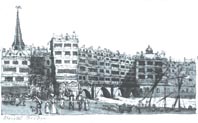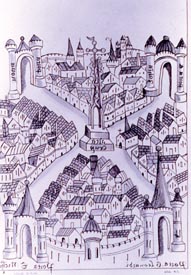|
|
 Early Bristol
Most towns are founded near the lowest bridgeable point on a river. Bristol is no exception. The Saxon settlement of Bricgstowe – the place of the bridge – grew up between the meeting place of the Rivers Frome and Avon. This illustration shows what the medieval bridge may have looked like.
 Early Settlement
The old city was established in the shape of the holy cross on higher ground above marshy land. This topography offered an ideal place to establish a settlement that could be defended from attack. The Avon Gorge and the river’s tides also provided natural protection. Invaders would be hopelessly vulnerable and probably get stuck trying to reach the town by coming up the river.
Bristol Castle
Following the Norman conquest, Bristol Castle was built. The River Frome was diverted into what is now known as St Augustine's Reach to enlarge the harbour. The town grew in importance as trading links were established with Ireland and Wales. English wool and cloth was exported to Europe. The principal import was wine from France. Merchants also brought salt and iron from Spain and fish from Scandinavia.
Medieval Exploration
It was in pursuit of fish – mainly cod – that Bristol seamen went first to Iceland and then to Newfoundland. It is also widely believed that Bristolians were in North America years before John Cabot's famous voyage from Bristol in 1497.
|
|


